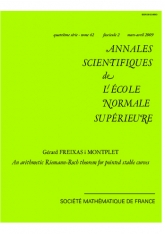Un théorème de Riemann-Roch arithmétique pour les courbes stables pointées
An arithmetic Riemann-Roch theorem for pointed stable curves

- Consulter un extrait
- Année : 2009
- Fascicule : 2
- Tome : 42
- Format : Électronique
- Langue de l'ouvrage :
Anglais - Class. Math. : 14G40, 11F72
- Pages : 335-369
- DOI : 10.24033/asens.2098
Soient $(\mathcal O, \Sigma , F_{\infty })$ un anneau arithmétique de dimension de Krull au plus 1, $\mathcal S=\mathrm {Spec}\mathcal O$ et $(\pi :\mathcal X\rightarrow \mathcal S; \sigma _{1},\ldots ,\sigma _{n})$ une courbe stable $n$-pointée de genre $g$. Posons $\mathcal U=\mathcal X\setminus \cup _{j}\sigma _{j}(\mathcal S)$. Le faisceau inversible $\omega _{\mathcal X/\mathcal S}(\sigma _{1}+\cdots +\sigma _{n})$ hérite une structure hermitienne $\|\cdot \|_{\mathrm {hyp}}$ du dual de la métrique hyperbolique sur la surface de Riemann $\mathcal U_{\infty }$. Dans cet article nous prouvons un théorème de Riemann-Roch arithmétique qui calcule l'auto-intersection arithmétique de $\omega _{\mathcal X/\mathcal S}(\sigma _{1}+\cdots +\sigma _{n})_{\mathrm {hyp}}$. Le théorème est appliqué aux courbes modulaires $X(\Gamma )$, $\Gamma =\Gamma _{0}(p)$ ou $\Gamma _{1}(p)$, $p\geq 11$ premier, prenant les cusps comme sections. Nous montrons $Z^{\prime }(Y(\Gamma ),1)\sim e^{a}\pi ^{b}\Gamma _{2}(1/2)^{c}L(0,\mathcal {M}_{\Gamma })$, avec $p\equiv 11\mod 12$ lorsque $\Gamma =\Gamma _{0}(p)$. Ici $Z(Y(\Gamma ),s)$ est la fonction zêta de Selberg de la courbe modulaire ouverte $Y(\Gamma )$, $a,b,c$ sont des nombres rationnels, $\mathcal M_{\Gamma }$ est un motif de Chow approprié et $\sim $ signifie égalité à unité près.

